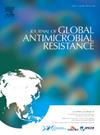Whole-genome sequence analysis of morphological changes in Haemophilus influenzae after beta-lactam exposure
IF 3.7
3区 医学
Q2 INFECTIOUS DISEASES
引用次数: 0
Abstract
This report describes mutations in genes responsible for cell deformities in haemophili under beta-lactam pressure in vitro. Light and transmission electron microscopy confirmed a hypothesis regarding changes in the shape of haemophili that had become more filamentous in the presence of ampicillin (2 mg/L) and cefuroxime (8 mg/L) after 30 days of serial passage. Short-axis size increased by 28% (from 0.767 to 1.06 µm) and long-axis length increased by 54% (from 1 to 2.175 µm). Additionally, whole-genome sequencing analysis (Illumina platform, software PROKKA) revealed a variety of mutations in genes responsible for cell morphology in isolates examined in this study: ftsI (A1576 → C; G1154 → C; T986 → C; G1684 → C), mreB (C476 → T), mreC (A5 → G), mrdA (A1148 → G; C179 → T; G1613 → T), mrdB (T668 → G), mltC (C1016 → T) and rodA (T668 → G). The results of this study indicate that shifts in bacterial shape could play a role in the adaptation of haemophili to a new niche created by beta-lactams as a strategy of antibiotic therapy survival.
对接触β-内酰胺后流感嗜血杆菌形态变化的全基因组序列分析。
本报告描述了在体外β-内酰胺类药物的压力下,导致嗜血杆菌细胞畸形的基因突变。光镜和透射电子显微镜证实了一种假设,即在氨苄西林(2 毫克/升)和头孢呋辛(8 毫克/升)的作用下,嗜血杆菌的形状在连续通过 30 天后会发生变化,变得更像丝状。短轴的尺寸增加了 28%(从 0.767μm 增加到 1.06μm),长轴的长度增加了 54%(从 1μm 增加到 2.175μm)。此外,全基因组测序分析(Illumina 平台,软件 PROKKA)显示,本研究中检测的分离株中负责细胞形态的基因发生了多种突变:ftsI(A1576 → C;G1154 → C;T986 → C;G1684 → C)、mreB(C476 → T)、mreC(A5 → G)、mrdA(A1148 → G;C179 → T;G1613 → T)、mrdB(T668 → G)、mltC(C1016 → T)、rodA(T668 → G)。这项研究的结果表明,细菌形状的改变可能是嗜血杆菌适应β-内酰胺类药物创造的新生态位的一种策略。
本文章由计算机程序翻译,如有差异,请以英文原文为准。
求助全文
约1分钟内获得全文
求助全文
来源期刊

Journal of global antimicrobial resistance
INFECTIOUS DISEASES-PHARMACOLOGY & PHARMACY
CiteScore
8.70
自引率
2.20%
发文量
285
审稿时长
34 weeks
期刊介绍:
The Journal of Global Antimicrobial Resistance (JGAR) is a quarterly online journal run by an international Editorial Board that focuses on the global spread of antibiotic-resistant microbes.
JGAR is a dedicated journal for all professionals working in research, health care, the environment and animal infection control, aiming to track the resistance threat worldwide and provides a single voice devoted to antimicrobial resistance (AMR).
Featuring peer-reviewed and up to date research articles, reviews, short notes and hot topics JGAR covers the key topics related to antibacterial, antiviral, antifungal and antiparasitic resistance.
 求助内容:
求助内容: 应助结果提醒方式:
应助结果提醒方式:


